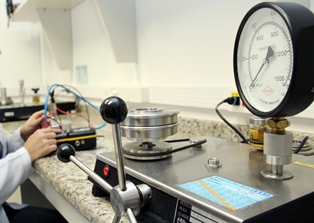Introduction
The pressure measurement procedure is widely widespread within industrial processes and embraces several areas, such as steel and metallurgical industries, automotive, meteorological, aviation, among others.
The reliability of these measurements is related with trade, quality, health and safety issues. In this way, a wrong measurement can create problems in the quality of the industrial process and even fatal accidents. Companies are looking for robustness and reliable ways to monitor their process. For this monitoring to be effective, it is not enough to have installed several devices and pressure gauges in the plan of the factory. It is necessary to be sure that the measured value by the instrument is correct. And that’s where Metrology comes in.
According to the international vocabulary of general and fundamental terms of metrology (VMI), metrology is a “measurement science” and covers all aspects that influence a measurement process. With the process of production globalization, metrology has a big importance as measurements are present in all decision-making processes and cover the industrial, commercial, health and environmental areas.
The calibration process of a pressure gauge is a complex activity and requires compliance with several requirements imposed by the related standards. Performing a calibration is the responsibility of laboratories certificated by Inmetro or at least laboratories related to Brazilian national standards.
Definitions
Pressure: The measure pressure is performed from a reference value. Depending on the reference use, the measured pressure modes are: absolute pressure, gauge pressure, vacuum and differential pressure.
Absolute Pressure: The absolute pressure (pabs) is the pressure that is above the “absolute zero” pressure.
Gauge Pressure (Relative or Positive): The gauge pressure is a special case of differential pressure measurement and occurs when the measured absolute pressure is greater than the local atmospheric pressure. The gauge pressure measures how much its value is above the local atmospheric pressure.
Vacuum (Negative Pressure): The vacuum is a special case of differential pressure measurement and occurs when the measured absolute pressure is lower than the local atmospheric pressure. The vacuum measures how much its value is above the atmospheric pressure.
Differential Pressure: The difference between two pressures p1 and p2 is called differential pressure. In this pressure mode, the value of the referential pressure, p1 or p2, is not the local pressure atmospheric.
Calibration: The calibration is the set of operations that establish, under specific conditions, the relationship between the values indicates in the measurement process and the corresponding values of the quantities stablished by standards.
Maximum Permissible Error: Extreme value of the measurement error, related to a known reference value, permitted by specifications or regulations for a given measurement, measuring instrument or measuring system.
Hysteresis error: Maximum difference between increasing and decreasing indications at any point on the scale in a calibration.
Repeatability error: Maximum difference between a consecutive number of indications for a same pressure, under the same operating conditions and under a same direction of pressure application.
Linearity error: Maximum difference between an obtained curve by the mean of the increasing and decreasing indications in a calibration and the theoretical line of the instrument.
Fiducial error: The fiducial error of a pressure gauge is determined from the association between the largest measurements errors of the instrument by the measured amplitude expressed as a percentage.
Note: The fiducial error determines the accuracy class of the instrument under calibration.
Accuracy class: Class of measuring instruments or measuring system that meet metrological requirements stablished to maintain measurement errors or instrumental measurement uncertainties within specified limits and under specified operating conditions.
Calibration – example for a digital manometer
The calibration consists of comparing the values indicated by the manometer being calibrated (LI) and the values indicated by the standard manometer (LPT) when submitted to the same levels of pressure (calibration points). In the calibration in question, it is used a method of indirect comparison. The pressure created by a helmsman (hydraulic pressure pump) and the values indicated by the manometer were compared with the values indicates by the standard manometer.
Data of the digital calibrated manometer:
Scale: 0 to 10 bar
Resolution: 0.01 bar
Accuracy class: A
Maximum error allowed: ± 1.0% of the full scale value.
Data of the digital standard manometer:
Scale: 0 to 35 bar
Resolution: 0.001 bar
Accuracy class: 5A
Note: The association between the accuracy of the standard and the instrument to be calibrated must be analyzed. To calibrate digital manometers, the standard must have at least a 4 times better resolution than the manometer in calibration, according to NBR 14105-2.
Calibration points:
According to standard NBR 14105-2, a manometer with an accuracy class “A” must be calibrated at least 5 points. When there is a zero point, it also must be verified.
Values found during a calibration:
Results obtained in a calibration
Metrological characteristics presented in: (bar)
Metrological characteristics presented in relation to instrument range amplitude (%)
Analyzing the results found in the calibration it is proved that the pressure gauge is presenting maximum error of indication (fiducial error) above the limit established for its accuracy class. It must be replaced or send to the manufacturer’s technical support for adjustments.
Conclusion
In the above example, it was detected that the measurement deviation of the manometer was about 30 % above the allowed value for its accuracy class. The impact of this deviation can be extremely harmful to the quality of the process to which the manometer is applied. Besides that, depending on the application, the safety and the integrity of the devices and the people involved in the process may be compromised.
This demonstrates the importance of metrology within industrial process and reinforces the idea that it is not enough to have a monitoring system. It is also necessary that the results presented by the system are reliable.
ABOUT THE AUTHOR :









